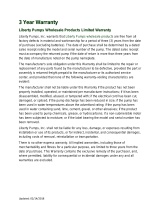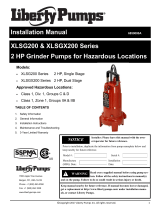
©Copyright 2013 Liberty Pumps Inc. All rights reserved
4
PUMP RUNS AND REMOVES WATER BUT DOES NOT SHUT OFF
1. Float is stuck in the “on” position. Check to make sure the float is free to move up and down without
obstruction.
2. Pump is installed on a non-level surface. Level the pump.
3. Switch is defective. Consult factory.
PUMP RUNS BUT DELIVERS VERY LITTLE WATER
1. Vertical lift is approaching the pump’s maximum lift capability. Refer to the above maximum lift chart.
2. Pump’s inlet is partially blocked. Check to make sure the inlet is clear of debris.
3. Discharge line is partially blocked. Check line for blockage.
4. Check valve is not opening all the way. Check for defective or blocked check valve.
CIRCUIT BREAKER TRIPS OR FUSE BLOWS WHEN PUMP STARTS
1. Fuse or breaker size is too small. A 15-amp breaker should be used.
2. Other major appliances are on the same circuit. Pump should be on its own circuit.
3. Pump is connected to an extension cord or wiring is inadequate. Have a certified electrician check for proper
wiring.
4. Defective motor or switch. Consult factory.
All Liberty pumps are designed and manufactured to ensure long, trouble-free service. However, if the pump is
used in a dirty environment or is pumping something other than clear condensate water, the tank should be
removed and cleaned periodically with soap and water.
Pump models have sealed permanently lubricated bearings and require no additional lubrication. Pour enough
water into the tank to activate the pump periodically when not normally in use.
If unit is mounted in an unheated area that is exposed to temperatures below freezing, the unit and lines must be
drained to prevent damage to the pump.
NOTE: Liberty Pumps, Inc. assumes no responsibility for damage or injury due to disassembly in the field. Disassembly, other
than at Liberty Pumps or its authorized service centers, automatically voids warranty.
Liberty Pumps, Inc. warrants that pumps of its manufacture are free from all factory defects in material and workmanship for a
period of 3 years from the date of purchase. The date of purchase shall be determined by a dated sales receipt noting the
model and serial number of the pump. The dated sales receipt must accompany the returned pump if the date of return is more
than 3 years from the "CODE" (date of manufacture) number noted on the pump nameplate.
The manufacturer's obligation under this Warranty shall be limited to the repair or replacement of any parts found by the
manufacturer to be defective, provided the part or assembly is returned freight prepaid to the manufacturer or its authorized
service center, and provided that none of the following warranty-voiding characteristics are evident.
The manufacturer shall not be liable under this Warranty if the product has not been properly installed; if it has been
disassembled, modified, abused or tampered with; if the electrical cord has been cut, damaged or spliced; if the pump
discharge has been reduced in size; if the pump has been used in water temperatures above the advertised rating, or water
containing sand, lime, cement, gravel or other abrasives; if the product has been used to pump chemicals or hydrocarbons; if a
non-submersible motor has been subjected to excessive moisture; or if the label bearing the serial, model and code number has
been removed. Liberty Pumps, Inc. shall not be liable for any loss, damage or expenses resulting from installation or use of its
products, or for consequential damages, including costs of removal, reinstallation or transportation.
There is no other express warranty. All implied warranties, including those of merchantability and fitness for a particular
purpose, are limited to three years from the date of purchase.
This Warranty contains the exclusive remedy of the purchaser, and, where permitted, liability for consequential or incidental
damages under any and all warranties are excluded.










